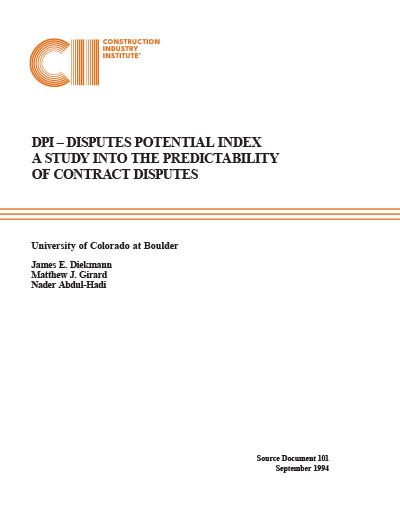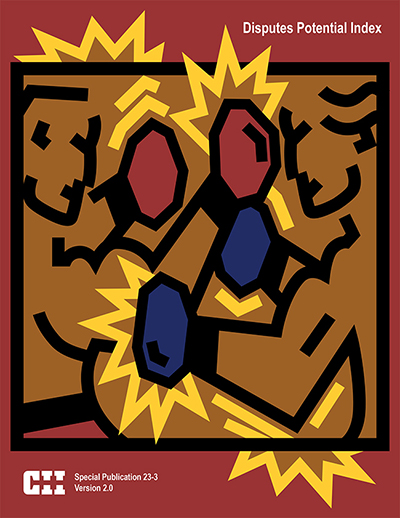
DPI - Dispute Potential Index: A Study into the Predictability of Contract Disputes
This report describes research conducted for the Dispute Prevention and Resolution Task Force of the Construction Industry Institute (CII). The research analyzes the effect of different project characteristics on the likelihood of project disputes and develops a computerized model to predict the likelihood of contract disputes. This report provides an explanation of the project characteristics that were evaluated, our data analysis techniques and the conclusions that we made about this work. This project is consistent with this emerging trend toward cooperative prevention and settlement of contract disputes. Fundamentally, this research attempts to develop a method to identify construction projects on which contract disputes are likely to occur, so the parties involved can take steps to reduce the likelihood of contract disputes. This research considered the impact of three categories of project characteristics on contract disputes. These characteristic classes are:
People: Issues involving people are extremely important when considering the number of organizations, relationships, roles, responsibilities, and the many different expectations that affect these people.
Process: Process issues, or the manner in which the contract and building process is carried out, include planning of the project; financial and scope definition; contractual obligations, contractual risk allocation, and contract administration procedures; quality of the construction documents used; and the use of dispute mitigation techniques.
Project: Project issues are those characteristics that define the technical nature of the work, such as the type and complexity of a project, the limitations of the site and the environment in which it is being proposed.
The findings of this work are based on a statistical analysis of data on the frequency and severity of disputes on various construction projects. A logistic regression model, the Disputes Potential Index (DPI), is created. The DPI model is based on responses from 159 individual projects. Data gathering was accomplished in two ways. First the CII Dispute Prevention and Resolution Task Force members distributed the data collection survey to project managers in their respective companies. Secondly, background data were also obtained from such large organizations as the Associated General Contractors, local contracting organizational groups, and large owner groups, such as public works and state transportation departments.
The DPI model includes 21 project variable questions, combined into eight hybrid input variables:
- Variable 1 (V1): Owner’s Management and Organization
- Variable 2 (V2): Contractor Management and Organization
- Variable 3 (V3): Project Complexity
- Variable 4 (V4): Project Size
- Variable 5 (V5): Financial Planning
- Variable 6 (V6): Project Scope Definition
- Variable 7 (V7): Risk Allocation
- Variable 8 (V8): Contract Obligations
These variables are described in detail in the report. DPI is delivered as a Microsoft Excel® spreadsheet. Its output classifies projects into one of five categories relative to the projects predilection for experiencing contract disputes.
The fundamental conclusions from the data analysis phase of the project are the following:
- People do not always cause disputes, but the quality of people invariably affects the disputes performance more than any other project characteristic. People either greatly help or greatly hinder the process of settling disputes.
- Of the “People” on the project, the Contractor’s personnel have the greatest opportunity to make an impact on the disputes climate of a project.
- The Project variables do not affect the project disputes performance to a great extent. Generally speaking, inherently tougher or more complex projects do not make much of an impact on the likelihood of contract disputes. In essence, disagreements on Projects issues will be settled by people.
- The impact of Process falls between the impact of Project and People. Pre-construction planning and contractual relationships can help or hinder a project more than Project issues can.
The other work by this task force urges project players to “start right” and “stay right” as regards contract disputes. The DPI can be used to both “start right” as part of a contract readiness review, and “stay right” if the project participants use it periodically to measure changes in the dispute climate of the project. DPI might serve a useful communication function if it were used as part of a partnering meeting.
The most important follow-on work for this project would be to fund a longitudinal study of the accuracy of the DPI. All of our analyses were accomplished retrospectively. A longitudinal study would allow for a DPI prediction and sufficient time to follow up on the prediction. Additionally, the views and insights of the participants in the longitudinal study regarding DPI’s impact on disputes avoidance and resolution would be invaluable.
We are encouraged by the results that we obtained from this research. However, none of this would be possible without the cooperation and support of the CII Disputes Avoidance and Resolution Task Force.


